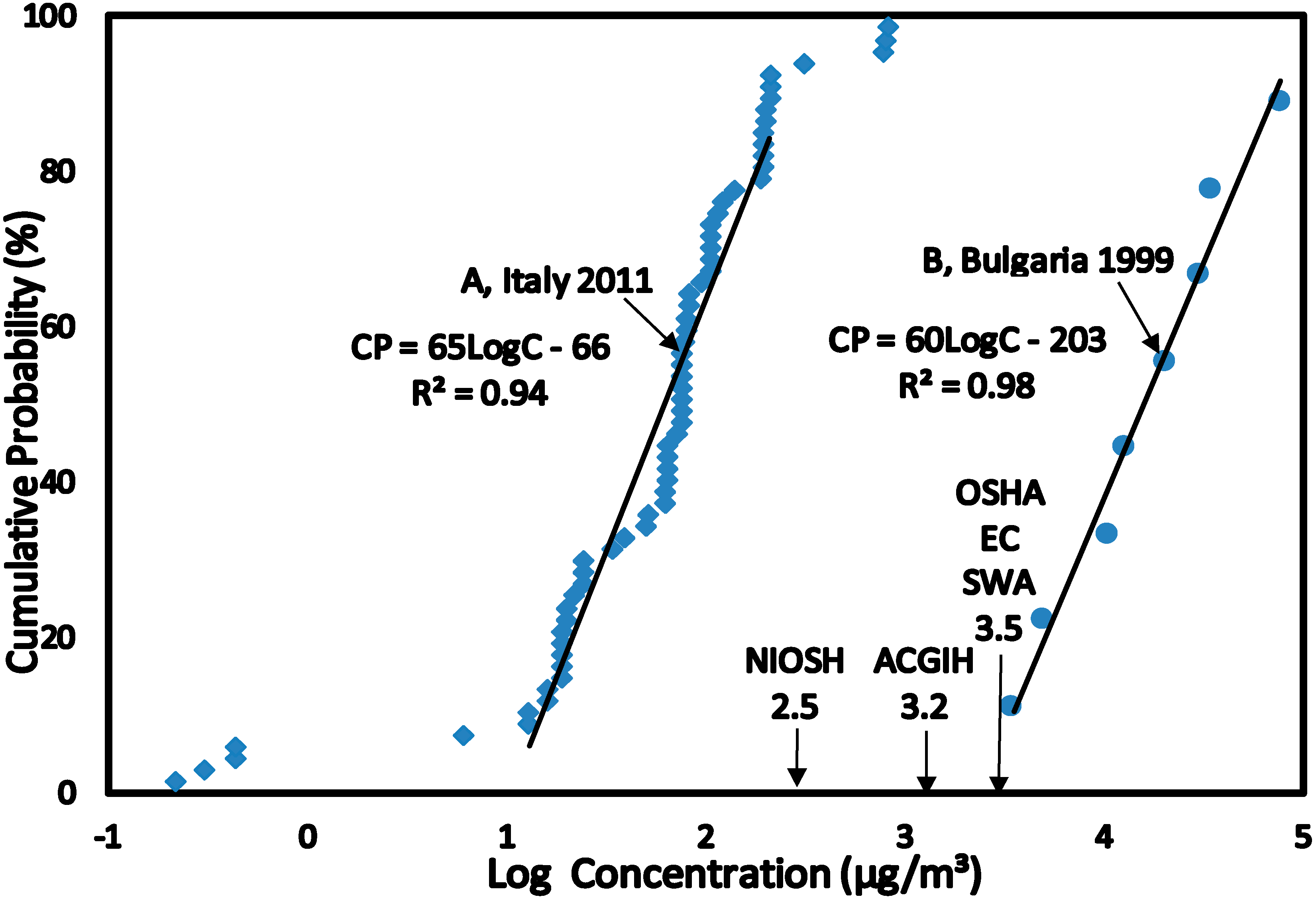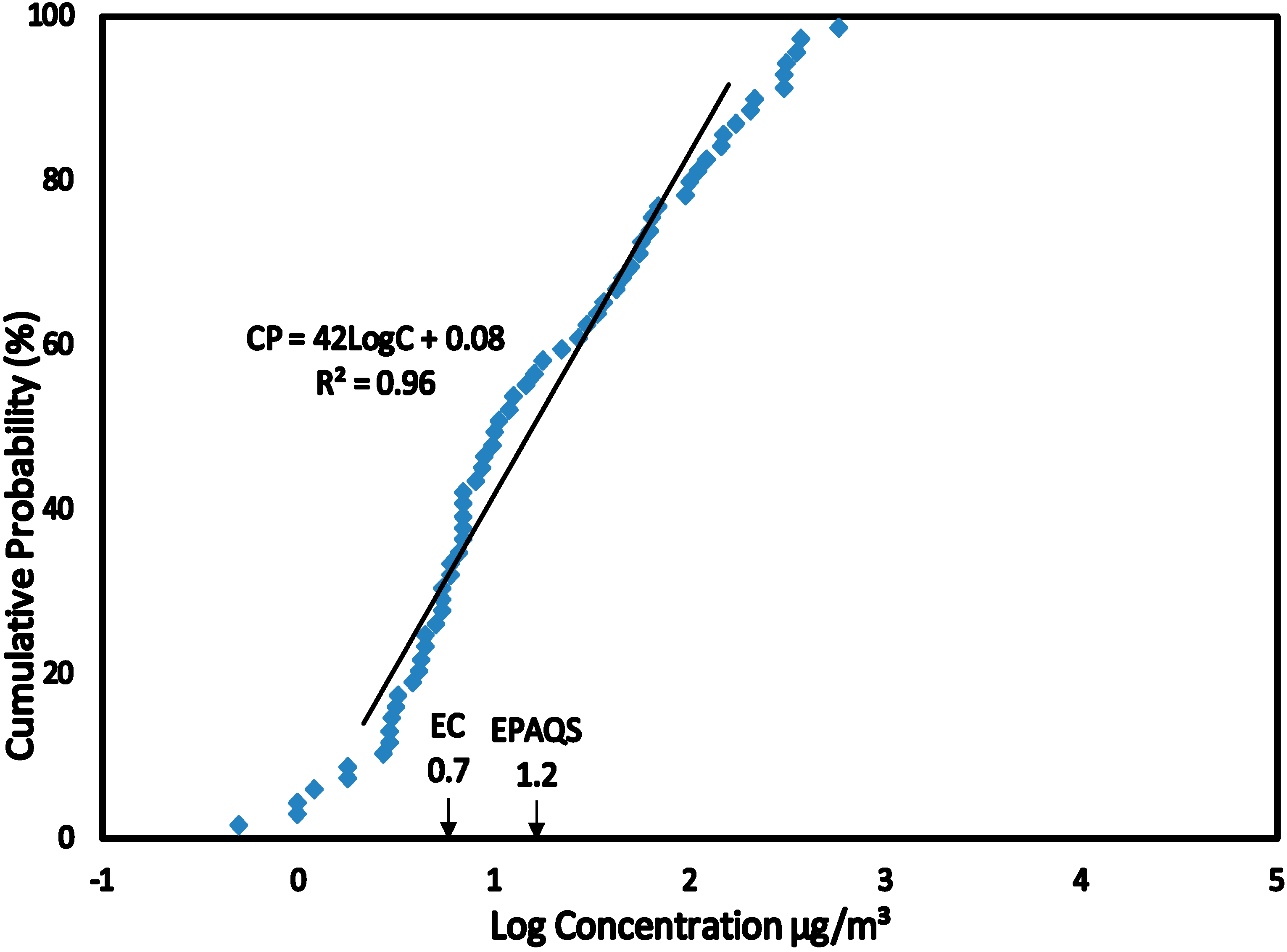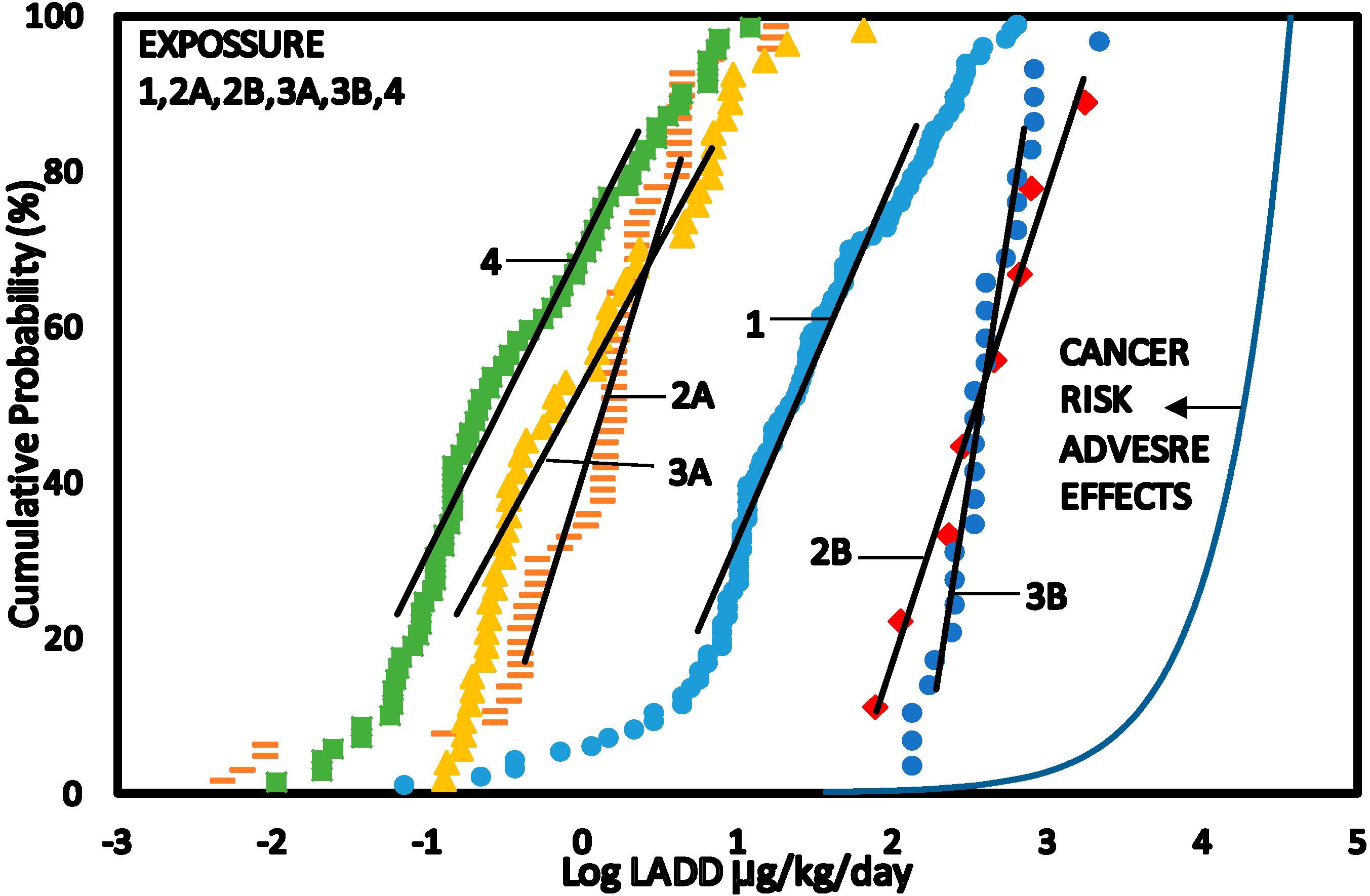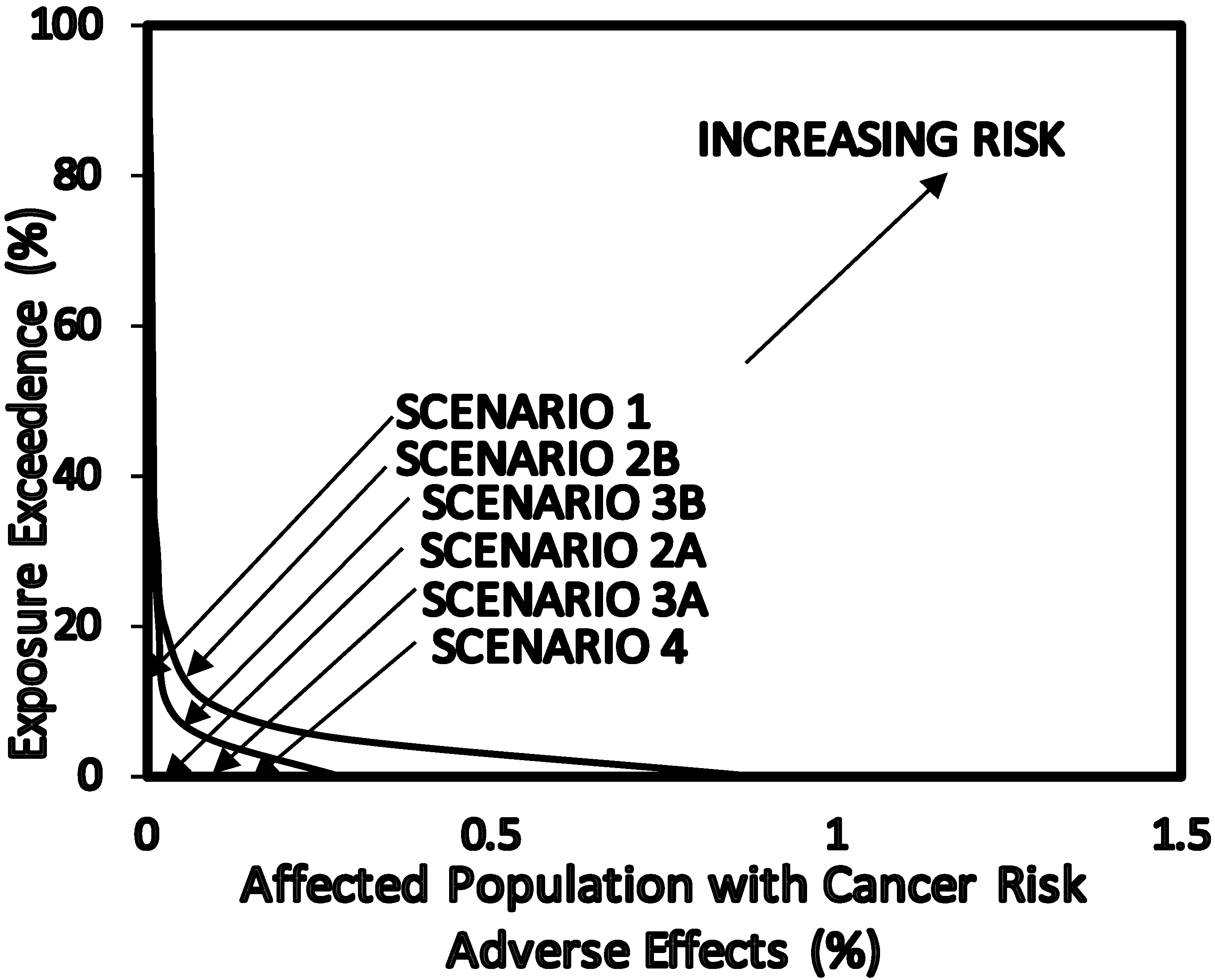Health Risk Assessment for Exposure to Benzene in Petroleum Refinery Environments
Abstract
:1. Introduction
2. Methodology
2.1. Research Strategy
| Reference | Description | Country | Sampling Method |
|---|---|---|---|
| [11] | Cytogenic biomonitoring on a group of petroleum refinery workers | Italy (two different Italian petroleum refineries) | P * |
| [2] | Cytogenic effects of Bulgarian petroleum refinery workers chronically exposed to benzene | Bulgaria (NEFTOCHIM oil company in Burgas) | P * and S * |
| [19] | Retrospective exposure assessment for benzene in the Australian petroleum industry | Australia (nine companies with employees participating in health watch) | BE * |
| [20] | Ensuring comparability of benzene exposure estimates across three nested case-control studies in the petroleum industry in support of a pooled epidemiological analysis | Canada, Australia, United Kingdom | BE * |
| [21] | Retrospective estimation of exposure to benzene in a leukaemia case-control study of petroleum marketing and distribution workers in the United Kingdom | United Kingdom (four companies in the petroleum marketing and distribution industry in the UK) | BE * |
| [1] | Seasonal variation of toxic benzene emissions in petroleum refinery | India (Digboi petroleum refinery at Gowahati | S * |
| [22] | Monitoring and analysis of volatile organic compounds around an oil refinery | Italy (a petroleum refinery in Valle Galeria, Rome) | S * |
| [10] | Volatile organic compounds in ambient air of Kaohsiung petroleum refinery | Taiwan, Kaohsiung refinery | S * |
2.1.1. Data Collection
2.1.2. Criteria for Data Selection
2.1.3. Preparation of Probability Distribution Plots
2.1.4. Guideline Values for Benzene
2.2. Data Analysis
2.2.1. Background
2.2.2. Scenario 1—Exposure to Benzene as Base Estimate Concentrations for Petroleum Refinery Workers
| Regulatory Body | Description | Benzene Concentration (µg/m3) |
|---|---|---|
| Occupational Exposure Limits (OEL) | ||
| American Conference of Governmental Industrial Hygienists (ACGIH), USA | Threshold Limit Values (TLV) | 1600 |
| Occupational Safety and Health Administration (OSHA), USA | Permissible Exposure Limit (PEL) | 3250 |
| National Institute for Occupational Safety and Health (NIOSH), USA | Recommended Exposure Limit (REL) | 325 |
| Safe Work Australia (SWA) | Occupational Exposure limit (OEL) | 3250 |
| European Directives 2000/39/EC and 97/42/EC (ED) | Limit Value (LV) | 3250 |
| Air Quality Guidelines (AQGs) | ||
| European Union Directives 2000/69/EC | Annual mean | 5 |
| Expert Panel on Air Quality Standards (EPAQS), United Kingdom | Annual mean | 16.25 |
2.2.3. Scenario 2—Exposure to Benzene for Petroleum Refinery Workers
2.2.4. Scenario 3—Benzene Concentrations in Air Inside the Petroleum Refineries
2.2.5. Scenario 4—Benzene Concentrations in Air Outside the Petroleum Refineries
2.3. Risk Characterization
2.3.1. Exposure Calculation




| Parameter | Unit | Default Value |
|---|---|---|
| Lifetime (LT) | years | 70 |
| Body Weight (BW) | kg | 70 |
| Exposure Length (EL) | day/day | 0.33 (8 h/day) (workers) |
| 0.17 (4 h/day) (outdoor) | ||
| Exposure Duration (ED) | years | 25 (commercial/industrial) |
| 30 (residential) | ||
| Inhalation Rate (IR) | m3/day | 20 |
| Inhalation Reference Dose (RfD) | mg/kg/day | 0.0085 |
| Slope Factor | (mg/kg/day)−1 | 0.0273 |
2.3.2. Use of the Hazard Quotient (HQ)
2.3.3. Cancer Risk
2.3.4. Evaluation Using Overall Risk Probability (ORP)

3. Results and Discussion
3.1. Scenario 1—Exposure to Benzene as Base Estimates for Petroleum Refinery Workers
3.2. Scenario 2—Exposure to Benzene for Petroleum Refinery Workers
3.3. Scenario 3—Benzene Concentrations in Air Inside the Petroleum Refineries
3.4. Scenario 4—Benzene Concentrations in Air Outside the Petroleum Refineries
3.5. Risk Characterization
3.5.1. Hazard Quotient (HQ)
3.5.2. Cancer Risk Calculated
3.5.3. Overall Risk Probability (ORP)

| Scenario | CEXP50 | LADD50 (µg/kg/Day) | CEXP95 | LADD95 (µg/kg/Day) | HQ at LADD50 | HQ at LADD95 | CR per 106 at LADD50 | CR per 106 at LADD95 | CR per 106 Estimated by ORP |
|---|---|---|---|---|---|---|---|---|---|
| Scenario 1 (Base Estimate) | 980 | 22 | 17,000 | 380 | 2.5 | 44 | 590 | 10,000 | 1700 |
| Scenario 2A (Refinery workers) | 75 | 1.7 | 690 | 16 | 0.20 | 1.9 | 45 | 420 | 110 |
| Scenario 2B (Refinery workers) | 17,000 | 370 | 79,000 | 1800 | 43 | 210 | 10,000 | 48,000 | 44,000 |
| Scenario 3A (Inside Refinery) | 22 | 0.6 | 480 | 14 | 0.068 | 1.8 | 18 | 460 | 150 |
| Scenario 3B (Inside Refinery) | 11,000 | 340 | 28,000 | 1000 | 39 | 120 | 9200 | 28,000 | 17,000 |
| Scenario 4 (Outside refinery) | 12 | 0.21 | 350 | 7.3 | 0.024 | 0.85 | 6.0 | 200 | 110 |
4. Conclusions
Acknowledgments
Author Contributions
Conflicts of Interest
References
- Rao, P.S.; Ansari, M.F.; Gavane, A.G.; Pandit, V.I.; Nema, P.; Devotta, S. Seasonal variation of toxic benzene emissions in petroleum refinery. Environ. Monit. Assess. 2007, 128, 323–328. [Google Scholar] [CrossRef] [PubMed]
- Mirkova, E.; Lalchev, S.; Alexandrova, E.; Antov, G.; Panev, T.; Tchohadjieva, D.; Gavrilova, N. Cytogenetic effects in lymphocytes of Bulgarian petroleum refinery workers chronically exposed to benzene: Comparisons of the cytokinesis—Block micronucleus assay and metaphase chromosome analysis. Eur. J. Gen Mol. Toxicol. 1999, 1999, 1–25. [Google Scholar]
- World Health Organization. Guidelines for Indoor Air Quality: Selected Pollutants; World Health Organization Regional Office for Europe: Copenhagen, Denmark, 2010. [Google Scholar]
- Agents Classified by the IARC Monographs, Volumes 1–111. Available online: http://monographs.iarc.fr/ENG/Classification/ClassificationsAlphaOrder.pdf (accessed on 8 January 2015).
- Rinsky, R.A.; Smith, A.B.; Hornung, R. Benzene and leukemia: An epidemiological risk assessment. N. Eng. J. Med. 1987, 316, 1044–1050. [Google Scholar] [CrossRef]
- Nordlinder, R.; Ramnnas, O. Exposure to benzene at different workplaces in Sweden. Ann. Occup. Hyg. 1987, 31, 345–355. [Google Scholar] [PubMed]
- World Health Organization (WHO). Air Quality Guidelines for EuropeWHO Regional Publications, European Series, No. 91; 2nd ed.; WHO Regional Office for Europe: Copenhagen, Denmark, 2000. [Google Scholar]
- Agency for Toxic Substances and Disease Registry. Toxicological Profile for Benzene; US Department of Health and Human Services: Atlanta, GA, USA, 2007. [Google Scholar]
- Capleton, A.C.; Levy, L.S. An overview of occupational benzene exposures and occupational exposure limits in Europe and North America. Chem. Biol. Interact. 2005, 153, 43–53. [Google Scholar] [CrossRef] [PubMed]
- Lin, T.Y.; Sree, U.; Tseng, S.H.; Chiu, K.H.; Wu, C.H.; Lo, J.G. Volatile organic compound in ambient air of Kaohsiung petroleum refinery in Taiwan. Atmos. Environ. 2004, 38, 4111–4122. [Google Scholar] [CrossRef]
- Basso, E.; Cevoli, C.; Papacchini, M.; Tranfo, G.; Mansi, A.; Testa, A. Cytogenetic biomonitoring on a group of petroleum refinery workers. Environ. Mol. Mutagen. 2011, 52, 440–447. [Google Scholar]
- Edokpolo, B.; Qiming, J.Y.; Connell, D. Health risk assessment of ambient air concentrations of benzene, toluene and xylene (btx) in service station environments. Int. J. Environ. Res. Public Health 2014, 11, 6354–6374. [Google Scholar] [CrossRef] [PubMed]
- Connell, D.W.; Fung, C.N.; Minh, T.B.; Tanabe, S.; Lama, P.K.S.; Wong, B.S.F.; Lama, M.H.W.; Wong, L.C.; Wu, R.S.S.; Richardson, B.J. Risk to breeding success of fish-eating Ardeids due to persistent organic contaminants in Hong Kong: Evidence from organochlorine compounds in eggs. Water Res. 2003, 37, 459–467. [Google Scholar] [CrossRef] [PubMed]
- Djohan, D.; YU, J.; Connell, D.; Christensen, E. Health risk assessment of chlorobenzenes in the air of residential houses using probabilistic techniques. J. Toxicol. Environ. Health 2007, 70, 1594–1603. [Google Scholar] [CrossRef]
- Hamidin, N.; Yu, Q.J.; Connell, D.W. Human health risk assessment of chlorinated disinfection by-products in drinking water using a probabilistic approach. Water Resour. 2008, 42, 3263–3274. [Google Scholar]
- Cao, Q.; Yu, Q.; Connell, D. Health risk characterisation for environmental pollutants with a new concept of overall risk probability. J. Hazard. Mater. 2011, 187, 480–488. [Google Scholar] [CrossRef] [PubMed]
- Yu, Q.J.; Cao, Q.; Connell, D. An overall risk probability-based method for quantification of synergistic and antagonistic effects in health risk assessment for mixtures: Theoretical concepts. Environ. Sci. Pollut. Res. 2012, 19, 2627–2633. [Google Scholar] [CrossRef]
- Phung, D.T.; Connell, D.; Miller, G.; Chu, C. Probabilistic assessment of chlorpyrifos exposure to rice farmers in Vietnam. J. Expo. Sci. Environ. Epidemiol. 2012, 22, 417–423. [Google Scholar] [CrossRef] [PubMed]
- Glass, D.C.; Adams, D.D.; Manuell, R.W.; Bisby, J.A. Retrospective exposure assessment for benzene in the Australian petroleum industry. Ann. Occup. Hyg. 2000, 44, 301–320. [Google Scholar] [CrossRef]
- Glass, D.C.; Armstrong, T.W.; Pearlman, E.D.; Verma, D.K.; Schnatter, A.R.; Rushton, L. Ensuring comparability of benzene exposure estimates across three nested case-control studies in the petroleum industry in support of a pooled epidemiological analysis. Chemo-Biol. Interact. 2010, 184, 101–111. [Google Scholar] [CrossRef]
- Lewis, S.J.; Bell, G.M.; Cordingley, N.; Pearlman, E.D.; Rushton, L. Retrospective estimation of exposure to benzene in a leukaemia case-control study of petroleum marketing and distribution workers in the United Kingdom. Occup. Environ. Med. 1997, 54, 167–175. [Google Scholar] [CrossRef] [PubMed]
- Gariazzo, C.; Pelliccioni, A.; Sallusti, F.; Cecinato, A. Monitoring and analysis of volatile organic compounds around an oil refinery. Water Air Soil Pollut. 2005, 167, 17–38. [Google Scholar]
- Chemical-Specific Reference Values for Benzene (CASRN 71-43-2). Available online: http://nepis.epa.gov/Exe/ZyPDF.cgi/P100KJIX.PDF?Dockey=P100KJIX.PDF (accessed on 8 January 2015).
- NIOSH Pocket Guide to Chemical Hazards. Available online: http://www.cdc.gov/niosh/npg/npgd0049.html (accessed on 8 January 2015).
- Safe Work Australia Workplace Exposure Standards for Airborne Contaminants. Available online: http://www.safeworkaustralia.gov.au/sites/SWA/about/Publications/Documents/639/Workplace_Exposure_Standards_for_Airborne_Contaminants.pdf (accessed on 8 January 2015).
- European Union. Directive 2000/69/EC of the European parliament and of the council of 16 November 2000 relating to limit values for benzene and carbon monoxide in ambient air. Off. J. 2000, 313, 12–21. [Google Scholar]
- Expert Panel on Air Quality Standards. Benzene, Department of the Environment Expert Panel on Air Quality Standards; HMSO: London, UK, 1994. [Google Scholar]
- Badjagbo, K.; Loranger, S.; Moore, S.; Tardif, R.; Sauvé, S. BTEX exposures among automobile mechanics and painters and their associated health risks. Hum. Ecol. Risk assess. Int. J. 2010, 16, 301–316. [Google Scholar]
- United State Environmental Protection Agency. Risk Assessment Guidance for Superfund: Human Health Evaluation Manual Supplemental Guidance “Standard Default Exposure Factors”; OSWER Directive: Washington, DC, USA, 1991; Volume 1, pp. 1–16.
- The Risk Assessment Information System. Toxicity and Physical Properties of Chemicals. Available online: http://rais.ornl.gov/cgi-bin/tools/TOX_search?select=chem (accessed on 8 January 2015).
© 2015 by the authors; licensee MDPI, Basel, Switzerland. This article is an open access article distributed under the terms and conditions of the Creative Commons Attribution license (http://creativecommons.org/licenses/by/4.0/).
Share and Cite
Edokpolo, B.; Yu, Q.J.; Connell, D. Health Risk Assessment for Exposure to Benzene in Petroleum Refinery Environments. Int. J. Environ. Res. Public Health 2015, 12, 595-610. https://doi.org/10.3390/ijerph120100595
Edokpolo B, Yu QJ, Connell D. Health Risk Assessment for Exposure to Benzene in Petroleum Refinery Environments. International Journal of Environmental Research and Public Health. 2015; 12(1):595-610. https://doi.org/10.3390/ijerph120100595
Chicago/Turabian StyleEdokpolo, Benjamin, Qiming Jimmy Yu, and Des Connell. 2015. "Health Risk Assessment for Exposure to Benzene in Petroleum Refinery Environments" International Journal of Environmental Research and Public Health 12, no. 1: 595-610. https://doi.org/10.3390/ijerph120100595
APA StyleEdokpolo, B., Yu, Q. J., & Connell, D. (2015). Health Risk Assessment for Exposure to Benzene in Petroleum Refinery Environments. International Journal of Environmental Research and Public Health, 12(1), 595-610. https://doi.org/10.3390/ijerph120100595






